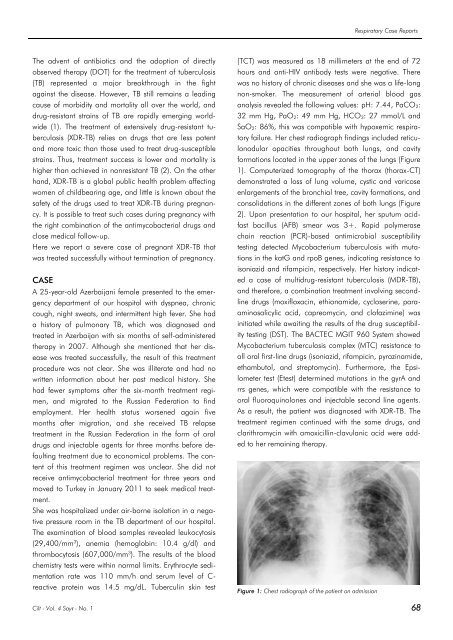Respircase Cilt: 4 - Sayı: 1 Yıl: 2015
You also want an ePaper? Increase the reach of your titles
YUMPU automatically turns print PDFs into web optimized ePapers that Google loves.
Respiratory Case Reports<br />
The advent of antibiotics and the adoption of directly<br />
observed therapy (DOT) for the treatment of tuberculosis<br />
(TB) represented a major breakthrough in the fight<br />
against the disease. However, TB still remains a leading<br />
cause of morbidity and mortality all over the world, and<br />
drug-resistant strains of TB are rapidly emerging worldwide<br />
(1). The treatment of extensively drug-resistant tuberculosis<br />
(XDR-TB) relies on drugs that are less potent<br />
and more toxic than those used to treat drug-susceptible<br />
strains. Thus, treatment success is lower and mortality is<br />
higher than achieved in nonresistant TB (2). On the other<br />
hand, XDR-TB is a global public health problem affecting<br />
women of childbearing age, and little is known about the<br />
safety of the drugs used to treat XDR-TB during pregnancy.<br />
It is possible to treat such cases during pregnancy with<br />
the right combination of the antimycobacterial drugs and<br />
close medical follow-up.<br />
Here we report a severe case of pregnant XDR-TB that<br />
was treated successfully without termination of pregnancy.<br />
CASE<br />
A 25-year-old Azerbaijani female presented to the emergency<br />
department of our hospital with dyspnea, chronic<br />
cough, night sweats, and intermittent high fever. She had<br />
a history of pulmonary TB, which was diagnosed and<br />
treated in Azerbaijan with six months of self-administered<br />
therapy in 2007. Although she mentioned that her disease<br />
was treated successfully, the result of this treatment<br />
procedure was not clear. She was illiterate and had no<br />
written information about her past medical history. She<br />
had fewer symptoms after the six-month treatment regimen,<br />
and migrated to the Russian Federation to find<br />
employment. Her health status worsened again five<br />
months after migration, and she received TB relapse<br />
treatment in the Russian Federation in the form of oral<br />
drugs and injectable agents for three months before defaulting<br />
treatment due to economical problems. The content<br />
of this treatment regimen was unclear. She did not<br />
receive antimycobacterial treatment for three years and<br />
moved to Turkey in January 2011 to seek medical treatment.<br />
She was hospitalized under air-borne isolation in a negative<br />
pressure room in the TB department of our hospital.<br />
The examination of blood samples revealed leukocytosis<br />
(29,400/mm 3 ), anemia (hemoglobin: 10.4 g/dl) and<br />
thrombocytosis (607,000/mm 3 ). The results of the blood<br />
chemistry tests were within normal limits. Erythrocyte sedimentation<br />
rate was 110 mm/h and serum level of C-<br />
reactive protein was 14.5 mg/dL. Tuberculin skin test<br />
(TCT) was measured as 18 millimeters at the end of 72<br />
hours and anti-HIV antibody tests were negative. There<br />
was no history of chronic diseases and she was a life-long<br />
non-smoker. The measurement of arterial blood gas<br />
analysis revealed the following values: pH: 7.44, PaCO 2:<br />
32 mm Hg, PaO 2: 49 mm Hg, HCO 3: 27 mmol/L and<br />
SaO 2: 86%, this was compatible with hypoxemic respiratory<br />
failure. Her chest radiograph findings included reticulonodular<br />
opacities throughout both lungs, and cavity<br />
formations located in the upper zones of the lungs (Figure<br />
1). Computerized tomography of the thorax (thorax-CT)<br />
demonstrated a loss of lung volume, cystic and varicose<br />
enlargements of the bronchial tree, cavity formations, and<br />
consolidations in the different zones of both lungs (Figure<br />
2). Upon presentation to our hospital, her sputum acidfast<br />
bacillus (AFB) smear was 3+. Rapid polymerase<br />
chain reaction (PCR)-based antimicrobial susceptibility<br />
testing detected Mycobacterium tuberculosis with mutations<br />
in the katG and rpoB genes, indicating resistance to<br />
isoniazid and rifampicin, respectively. Her history indicated<br />
a case of multidrug-resistant tuberculosis (MDR-TB),<br />
and therefore, a combination treatment involving secondline<br />
drugs (moxifloxacin, ethionamide, cycloserine, paraaminosalicylic<br />
acid, capreomycin, and clofazimine) was<br />
initiated while awaiting the results of the drug susceptibility<br />
testing (DST). The BACTEC MGIT 960 System showed<br />
Mycobacterium tuberculosis complex (MTC) resistance to<br />
all oral first-line drugs (isoniazid, rifampicin, pyrazinamide,<br />
ethambutol, and streptomycin). Furthermore, the Epsilometer<br />
test (Etest) determined mutations in the gyrA and<br />
rrs genes, which were compatible with the resistance to<br />
oral fluoroquinolones and injectable second line agents.<br />
As a result, the patient was diagnosed with XDR-TB. The<br />
treatment regimen continued with the same drugs, and<br />
clarithromycin with amoxicillin-clavulanic acid were added<br />
to her remaining therapy.<br />
Figure 1: Chest radiograph of the patient on admission<br />
<strong>Cilt</strong> - Vol. 4 <strong>Sayı</strong> - No. 1 68

















